|
Index...
|
 orn to Gerald John and Lilian Elsa Anne Porter (who was one of twins with Aunty Ivy), Brian was the youngest of five children. He was born in Carlton Road, Foleshill Coventry, on 21st March 1938. They were three boys and two girls, the eldest and firstborn son was Reginald Edward who joined the Royal Air Force at the age of 17, and was consequently not often at home during Brian's early years.
orn to Gerald John and Lilian Elsa Anne Porter (who was one of twins with Aunty Ivy), Brian was the youngest of five children. He was born in Carlton Road, Foleshill Coventry, on 21st March 1938. They were three boys and two girls, the eldest and firstborn son was Reginald Edward who joined the Royal Air Force at the age of 17, and was consequently not often at home during Brian's early years.
Flight Sergeant R. E. Porter 830524 was the pilot of a Lancaster bomber and sadly died during bombing raids over Germany in the Second World War. Reg's name is listed among the other Coventrians who gave their lives for our freedom, on the Memorial monument in Coventry's Memorial Park, designed by Thomas Francis Tickner and built by John Gray, who also built Courtaulds factory. A visit to the Chamber of Silence, within the monument, brought us to a reverent moment of grateful remembrance as children.
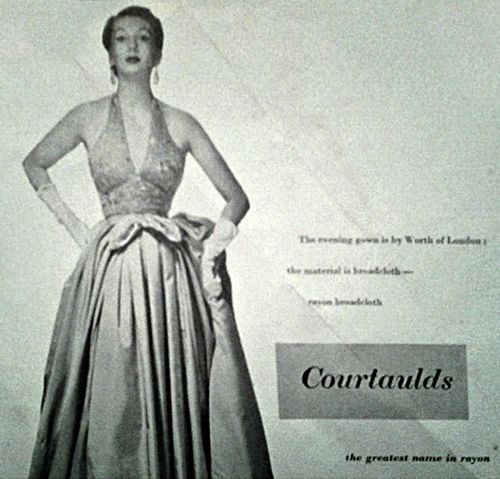
Brian has only brief memories of Reg, being so young when he died, but the whole family constantly remember him and keep a photograph of him, in RAF uniform, on the wall of the living room. Although he did not know it, Brian was also to join the Royal Air force in later life. Brian's other brother is William Guy, known to his friends as Bill. He is ten years older than Brian and he chose to go in the Army. He was a Scoutmaster, and a toolmaker by trade. Brian had two sisters, Margery (Marge), who is fifteen years older than Brian, and Vera, who is eight years older. The family had the usual childhood illnesses but a particularly trying time would have been when both Brian and his mother had scarlet fever together. Formerly a terrifying illness, it was thankfully by the 1940s completely curable.
Carlton Road was close to the Courtaulds textile factory at Little Heath, which was built in the 1920s close to the canal on which barges were regularly seen carrying cargo and coal and being pulled by shire horses. As children we enjoyed watching the horses being unhitched at tunnels and bridges, and being walked across the top while the men on the barges legged it through the tunnels. At the other side the horses were harnessed again and their journey continued. This was the main method of transport for the main Courtaulds factory on Foleshill Road and Holbrooks Lane, which was built close to the bridge on Foleshill Road closer to the City Centre, and was an imposing building with a large clock which could be seen from all four sides. It was a well known landmark. Wherever Courtaulds were producing man-made fibres, like rayon or acetate, there was a strong chemical smell in the air.
During WW2 Brian's father was in the Home Guard and was called on whenever needed by the community. This was in dire circumstances at times due to the bombing raids by the Luftwaffe. They had done reconnaissance prior to the declaration of war but were not always accurate when dropping bombs, and civilians were often killed as they missed their set targets. In spite of the barrage balloons along the Foleshill Road, Little Heath Courtaulds, close to Brian's family home, was a target because they produced synthetic yarn like nylon which was used for making parachutes. The parachutes were often cut up and the "parachute silk" was used for making wedding dresses of war-time brides. A bomb was dropped on Courtaulds and also in Lynton Road nearby, and many bombs were dropped along the Foleshill Road where there was a nearby Gasworks and which was also the area where aircraft components and supplies for transport were produced. Sterling Metals in Northey Road, which became significant to Brian, produced aluminium and metal alloy parts. With so much industry in the area, and the nearby canal - a useful means of transport in the war - it was a dangerous time for schoolchildren. Brian's family, like so many others, erected an air raid shelter in the garden. This was an Anderson shelter which could be bought for £7 by those who could afford to pay, but was given free to those who could not. It was very approx. 7ft. by 4ft. 6ins. It was seated below the earth level, very cold and damp, and did not keep out the noise of the bombing in spite of the steel door. People did not like to use them at all, but along with the Morrison shelter for those with no garden, which was like a metal table with the steel wire enclosure protecting the bed beneath, they served their purpose and no doubt saved many lives.

It was a sad and shocking journey to go upstairs on a double-decker bus into the stricken City Centre, then called Broadgate, to view the devastation of the blitz (despite gas filled barrage balloons placed strategically to deter low flying aircraft), and to look down on the huge crater left by the bomb which demolished Owen Owen, the department store, to see the other ruins like Woolworths and the old Arcade market area, and so sadly to see the Cathedral ruined beyond repair. Today St. Michael's remains in its ruined state as a stark reminder of man's folly. Large nails found in the ruins were placed together to form a cross and they remain there with the words "Father Forgive" below them. There is now also a Peace Garden in Coventry City Centre, designed and planted to help towards healing and forgiveness.
Carlton Road had a railway track for goods at one end, and Little Heath school at the other. Lairds ribbon weaving factory was directly opposite the Carlton Road houses.
 rian started school at Little Heath Primary school in 1942 when he was four years old most probably, although it could have been 1943. The school was literally just around the corner. School milk was delivered to schools in metal crates and the children had their turn at being milk monitor, counting one bottle for each class member, carrying the crate into the classroom, piercing the cardboard top on the bottle and putting the straws into the bottles, which held about a third of a pint of milk. At that time the Ministry of Health issued every child a daily dose of cod liver oil. Some orange juice and Virol was often given to children too, so in spite of it being war-time the children grew to be fitter then than ever before. When starting school, Brian would have learned to write, first of all on a small blackboard with chalk. Mr. and Mrs. Peg would probably have been his first reading book, progressing to Janet and John and Royal Road readers. As Brian's writing progressed he would have used a pencil and then a nibbed pen, which was dipped in the ink well on each desk. These inkwells were sometimes clogged with blotting paper or other rubbish which resulted in the dipped nib becoming fibrous, crossed and sometimes unusable. The teacher had to be asked whenever a new nib was needed and sometimes a disappointed child would be told "That one is alright, I think it will last a while longer."
rian started school at Little Heath Primary school in 1942 when he was four years old most probably, although it could have been 1943. The school was literally just around the corner. School milk was delivered to schools in metal crates and the children had their turn at being milk monitor, counting one bottle for each class member, carrying the crate into the classroom, piercing the cardboard top on the bottle and putting the straws into the bottles, which held about a third of a pint of milk. At that time the Ministry of Health issued every child a daily dose of cod liver oil. Some orange juice and Virol was often given to children too, so in spite of it being war-time the children grew to be fitter then than ever before. When starting school, Brian would have learned to write, first of all on a small blackboard with chalk. Mr. and Mrs. Peg would probably have been his first reading book, progressing to Janet and John and Royal Road readers. As Brian's writing progressed he would have used a pencil and then a nibbed pen, which was dipped in the ink well on each desk. These inkwells were sometimes clogged with blotting paper or other rubbish which resulted in the dipped nib becoming fibrous, crossed and sometimes unusable. The teacher had to be asked whenever a new nib was needed and sometimes a disappointed child would be told "That one is alright, I think it will last a while longer."
Sometimes, early in spring, a child would have been searching in ponds for frog spawn or crested newts, and they would carry the frogspawn into school for the class to observe the fins and back legs growing and the tail diminishing as the change to frogs became apparent, at which time the teacher would ask for a volunteer to return them to the pond. Bird's eggs were never brought into school, as the rule was to look carefully but don't touch!
Brian also went to Boys Brigade each week in the Church Hall, also very nearby, on the corner of Old Church Road, where he played football, and he very soon showed his love of sport. As he grew up he often helped the men who delivered bread and milk by horse and cart. In the 1920s milk was taken round in a churn and housewives took their jugs to be filled by the milkman who used a ladle measure. Glass milk bottles were introduced in 1930s and had to be rinsed and returned. Not infrequently broken glass would have to be carefully cleared away from doorsteps, and the spilled milk washed away. Deliveries eventually progressed to electric milk floats and to vans. Freshly baked bread was delivered and was also available from the bakery opposite Mr. Harris's shop on the corner of Mason Road. When the horse and cart came round, some residents used to have their bucket and shovel handy to collect manure dropped in the road for their gardens. Growing your own vegetables was a way of feeding the family when food was short and so much was on ration. For those who did not have home-grown vegetables they could also be bought from the greengrocer with the horse and cart. Coupons from the ration books were taken to the shop and allowed the family just an allocated amount of, for instance, tea or sweets. Families would sometimes swap coupons. Coal was also delivered by the coalman on his horse and cart; he wore a leather apron and shoulder covering, and he would lift the sack of coal off the cart, on to his shoulder, and carry it to offload into the cellar or an allocated space accessible to the householder who'd bought it, e.g. their back yard. Any small pieces of coal would be collected by the children and taken home because there was no central heating and it was sometimes so cold in winter that beautiful feathery, ferny patterns of ice formed on the inside of the bedroom windows and had to be scraped off. When Christmas came children would hang a sock up at the end of their bed for Father Christmas to fill with an apple, an orange, some nuts and some sweets. A sixpence was a special treat and then they would receive their main presents of board games or perhaps roller skates or a football. The 'table tennis bat' with a swinging weight beneath it and chickens which pecked as it swung was a favourite with children. Food parcels would arrive from Canada with tinned fruit, boxed dates and other things including the rosiest of red apples which polished up beautifully!
Brian had a dog called Bruce, which was a constant companion and he loved to take the dog for long walks. He and the other neighbourhood boys spent the long summer holidays playing games like Hide and Seek or Rat Tat Ginger, when they hid and watched as one boy (or girl) knocked on the door of a house and ran away to hide. They had great fun watching the puzzled tenant open the door and look around to see who had knocked. Another game was Conkers and each boy tried his own special way of hardening his conker to keep it from shattering when, after it had been pierced and threaded on a string, it was used for three tries at a time to strike the opposing player's conker, which he held aloft dangling from the string. The aim was to own the conker with the highest demolition score. They used to say "Mine's a fiftier, what's yours?" It was great to boast of a "hundreder"! French cricket and rounders were also played, and Tik Tak, or Tippit, where a piece of wood was sharpened at each end and struck with a stick to make it "jump" into the air, where it was hit again as far as possible to enable the player to score runs, was also popular.
As they got older they liked to go walking, and later riding their bikes sometimes along Beresford Avenue and Durbar Avenue and, passing the Black Pad, would cross over Lockhurst Lane bridge, past the Dunlop (where they made tyres and brake pads, rubber connections hoses etc., and where they had previously made barrage balloons to help in the war), and up Holbrooks Lane and on to Keresley.
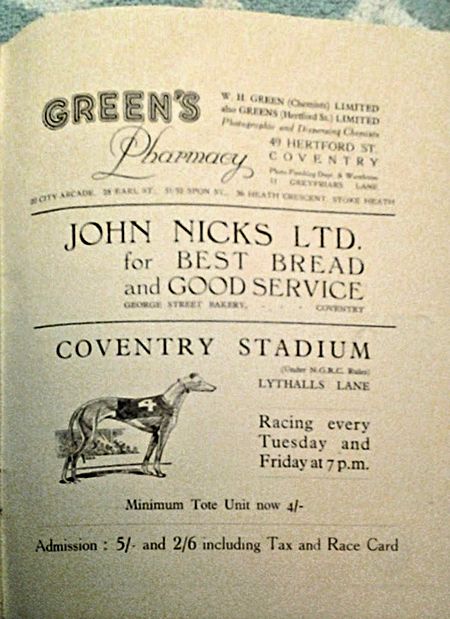
Sometimes they would go via Lythalls Lane, passing Self Changing Gears and the dog racing track where meetings were held twice a week, and then again, on to Holbrooks Lane and onward to Corley Rocks. This was an adventure paradise for children. The great red rocks formed caves and valleys where the most exciting stories of the Black Hand Gang or Dick Barton Special Agent could be enacted. The scope for imagination was endless and long days were happily spent here. As they got older, Brian and his mates went to the pictures on Saturday mornings and watched Laurel and Hardy, Old Mother Riley, Popeye, The Three Stooges, and cowboys like Gene Autry and his Four legged Friend, who was "faithful right up to the end, my wonderful one, two, three, four legged friend", and Roy Rogers and his horse, Trigger. Bud Abbott and Lou Costello were favourites too. The Rivoli, and The Roxy on the Foleshill Road, almost opposite Kingfield Road where the Cash's bookmarks and silk woven pictures were produced, were where Brian went to see the films usually, but a great treat for Coventry children was to go to the Gaumont children's club in Hales Street, where they had an organist seated before a huge pipe organ, who rose through a trap door and played music (see footnote), and the children had a great sing song before the films began. When it was time for the films to start, the organist and the organ descended below the stage and the trap door closed again. When there was sufficient money we would have a very rare treat and call in to the ice cream parlour almost next door for a nickerbocker glory; scoops of different flavoured ice cream, with fruit, and topped with a squirt of either strawberry or raspberry sauce, served in an inverted cone shaped glass with an extra long handled spoon. The ice-cream which was delivered by van around the streets of Coventry was from D. Di Mascio on Stoney Stanton Road, by the Red House motor company, or by Victor's, near to the Gaumont cinema. Another ice-cream parlour was in King William Street, Hillfields, near the Palladium, an area which was also badly bombed in the blitz.
As well as going to the pictures, there was also a Pantomime to go to. Street parties had been organised for V. E. Day (Victory in Europe Day) but Companies like Alfred Herbert's, machine tool manufacturers, at Edgewick, Foleshill, organised visits to the Coventry Hippodrome opposite the Fire Station and adjacent to Lady Herbert's Garden. This garden was designed by Sir Alfred Herbert (whose factory was in Edgewick, Foleshill), in memory of his second wife, Florence. It was designed, planted and opened in the 1930s, and is built between the Swanswell Gate and Cook Street Gate, either side of the City Wall. Two blocks of Almshouses, part of the design, were damaged in the Coventry blitz. They have been renovated, and today, along with the commemorative garden, I believe are managed by the City Council.
The hilarity of the Pantomime, almost next door, was a sharp and welcome change for everyone immediately after the bleak war years.
 s Brian grew towards his teens he was able to spend school holidays with his sister Vera, who had married Mal by this time and moved to South Wales. He loved it there, where his sister cooked huge meals, and where he generally received special "maldod" or Welsh spoiling, from everyone - a tradition he thought worth preserving at home! He was always given a warm welcome by Mal's relatives in Tumble, May and Will, who fostered an evacuee throughout and after the war, and who all looked forward to Brian's arrival for the long school holidays.
s Brian grew towards his teens he was able to spend school holidays with his sister Vera, who had married Mal by this time and moved to South Wales. He loved it there, where his sister cooked huge meals, and where he generally received special "maldod" or Welsh spoiling, from everyone - a tradition he thought worth preserving at home! He was always given a warm welcome by Mal's relatives in Tumble, May and Will, who fostered an evacuee throughout and after the war, and who all looked forward to Brian's arrival for the long school holidays.
As one would expect Brian was in his element when brother in law, Mal, arranged for Brian to have a game of Rugby for Tumble village, the local team, or took him to watch Llanelli play a home match. Brian has treasured his Sospan fach lapel pin, which he bought at Llanelli's ground, for years!
He had changed schools by now and had a long walk to Broad Street Secondary school where he had classes in woodwork and metalwork along with the main subjects. This encouraged an interest in industry, and in 1951 his father took him to London to see the Festival of Britain, which was to mark the centenary of The Great Exhibition, and was instigated and organised by Clement Attlee's Government to give Britain a feeling of wellbeing and progress shortly after the war ended and reconstruction was underway.
It was hoped it would boost industry by increasing exports, but it did not go international because of the cost at a time when reconstruction was so necessary. It was however described as "a tonic for the nation." It was a visit and a special time with his father that Brian would never forget.
At Broad Street School under the coaching and tutelage of Headmaster "Pop" Suddens, and his deputy, Harry Whapples, Brian's patriotism and passion for England grew. During assembly when schoolchildren prayed daily for their Country and their King, the boys sang Jerusalem with great gusto - a favourite song of Brian's to this day. He also loves Land of Hope and Glory. Brian's love of sports developed further. Helped by Mr. Windridge, Pop Suddens and Harry Whapples, he enjoyed cricket and his passion for Rugby Union took hold.
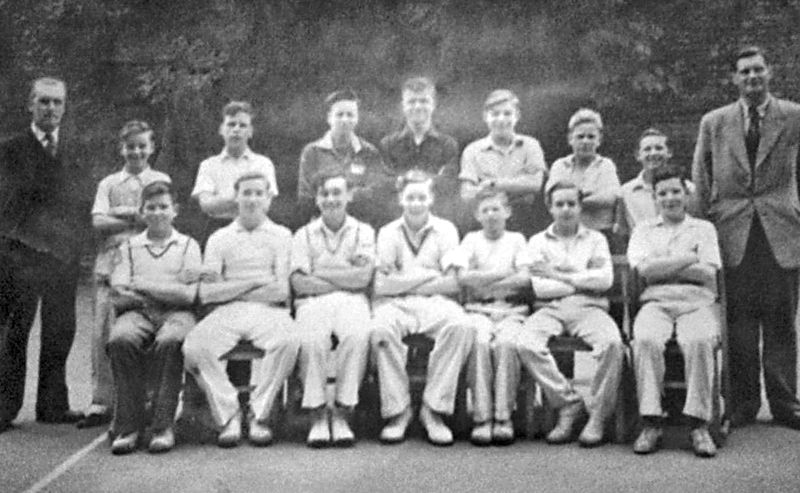
Special friends like Bill Greenway, Tony Lissaman, Don Ireland and Bill Kirkwood all had a talent and a passion for Rugby. Brian played for Warwickshire Colts along with Bill Greenway. Brian took part in trials for Warwickshire and stayed at Bisham Abbey in Berkshire for a while, receiving training and coaching. This was the place where training took place for England Rugby. Brian took part in international trials too.
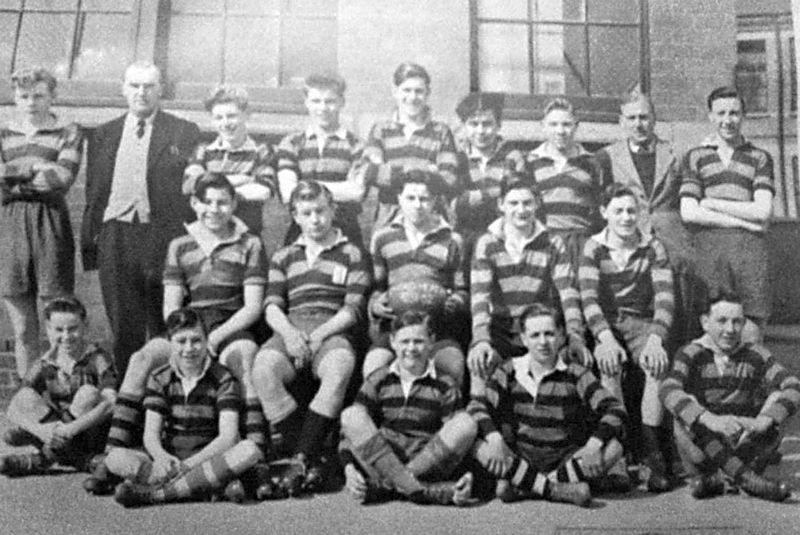
The boys at Broad Street often became life-long friends, like George Morris, an older but special friend, who also played on the cricket team with Brian, and who became a car renovator, filler and paint sprayer. Ron Moorcroft, whose favourite party piece was to strip to the waist, kneel on the table "paddle" his canoe vigorously and sing "Whim-O-Wey, a Whim-O-Wey" to everyone's delight as they all joined in the chorus. Don Branston, who later managed the bar and the Old Boys Club, Lincoln Bailey from Felin Foel, who later built himself a Kit Car and gained everyone's admiration. Bill Greenway and Tony Lissaman, who lived near the Ordnance Depot in Henrietta Street, Red Lane, and who both later went into the Army, after which Tony worked as a car mechanic and renovator, and Tony's elder brother Gordon became a butcher. Tony Lissaman also played for Warwickshire youth. Don Ireland, who played the trombone in the Salvation Army, also went into the Royal Air Force at the same time as Brian, and became a metallurgist at Sterling Metals.
Brian took his passion for Rugby seriously and trained regularly on weekdays to be fit and ready for selection at the weekend for inter-school matches - Barker Butts and Stoke Heath among others proving to be formidable rivals.
Eventually the Broad Street Old Boys Rugby Club was founded by Eric Lambert (who was ex King Henry VIII but who had a passion for Broad Street Rugby), Ray Brookes, Jim Hilton, Jim Houghton, Jim Wells and Maurice and Wally Dodd, who were brothers, along with others, all becoming founder members. Eric Lambert and his wife Iris were issued membership cards Nos. 1 and 2.
The meetings were held in the Fire Station opposite Old Church Road. They held Social evenings and dances to raise money, and members were given enough money to choose and buy a record of their preference to bring to the evening dance for everyone to enjoy. As Sarah was now working in Elkay's Jewellers Shop, almost next door to Payne's music shop in Far Gosford Street, Brian agreed she should buy the record they had chosen; it was "First you put your two knees close up tight, you swing them to the left and you swing them to the right." Well, no thought was given to specific musical arrangements and so the record was ordered. When it was played at the social evening it was slow. I mean sl-o-o-o-w, and everyone boo-ed and shouted "Who bought this?!!!!" That took some living down!
On leaving Broad Street school Brian undertook a six year apprenticeship with Sterling Metals in Northey Road. Sterling Metals were "Pioneers in this country of Elektron magnesium alloy castings and the largest producers of magnesium castings in the world." He was able at times to walk part of the way to work with his father, who went to Courtaulds every day. Brian worked under the guidance of John (Jack) Baldwin, who was a practical joker (and who was artistically gifted, and able to do the most beautiful calligraphy), but took his role, as Brian's main instructor in the factory, seriously. An electrician cannot afford carelessness or mistakes, and over the six years Brian learned everything about electrical installation and factory maintenance. He also improved his skills in using tools by making such things as a small brass anvil and a brass box with a snugly fitting lid, which were treasured. He played both Rugby and Cricket for Sterling Metals, who moved to Gypsy Lane in Nuneaton. While he was there Brian and his team all won Tug o' War medals.
He now cycled miles to and from work in Nuneaton daily, which also helped to keep him fit.
 here was a thriving Youth Club in John Gulson School in Leicester Causeway and George Street, and Brian and his schoolmates started going there. Incidentally, close to John Gulson school railings in George Street there was a "Tardis" police telephone box. It was at John Gulson youth club Sarah and Brian met when they were fifteen and sixteen respectively. Everyone at the club knew everyone else and played Table Tennis, Rugby Touch and learned Logarithms, or almost anything else they were having problems with, while socialising and having fun. Ray Hammond used to play the trumpet, we loved that. He also had a good singing voice, and on one occasion sang Jerusalem on a school visit to The Central Hall. The Youth Club was run by two very special and well respected men who kept order. The school was also used for Naval Cadets who held Band practice there. Girls and boys mixed easily and learned to rock and roll there too, to the music of Bill Hayley, the Everley Brothers, Elvis Presley or Buddy Holly, among others. For a short while Brian kept company with Katie Green, Sarah's good friend and close neighbour. Sarah and Tony Lissaman were special friends. Tony was Brian's friend and schoolmate. Tony was later to meet Val and have a long and happy marriage. There was a time when Katie and Sarah agreed to join the lads at Brian's house to go on a training run with them. After the route was decided upon - along Old Church Road, down Proffitt Avenue, on to Bell Green Road, and back via Gayer Street - the boys set off with the girls following but the rear view of the group of boys was so comical to the girls and they giggled so much they were in a state of collapse on the first corner! There they stayed giggling and exhausted until the boys completed their run, and they all went back to Brian's house for refreshments.
here was a thriving Youth Club in John Gulson School in Leicester Causeway and George Street, and Brian and his schoolmates started going there. Incidentally, close to John Gulson school railings in George Street there was a "Tardis" police telephone box. It was at John Gulson youth club Sarah and Brian met when they were fifteen and sixteen respectively. Everyone at the club knew everyone else and played Table Tennis, Rugby Touch and learned Logarithms, or almost anything else they were having problems with, while socialising and having fun. Ray Hammond used to play the trumpet, we loved that. He also had a good singing voice, and on one occasion sang Jerusalem on a school visit to The Central Hall. The Youth Club was run by two very special and well respected men who kept order. The school was also used for Naval Cadets who held Band practice there. Girls and boys mixed easily and learned to rock and roll there too, to the music of Bill Hayley, the Everley Brothers, Elvis Presley or Buddy Holly, among others. For a short while Brian kept company with Katie Green, Sarah's good friend and close neighbour. Sarah and Tony Lissaman were special friends. Tony was Brian's friend and schoolmate. Tony was later to meet Val and have a long and happy marriage. There was a time when Katie and Sarah agreed to join the lads at Brian's house to go on a training run with them. After the route was decided upon - along Old Church Road, down Proffitt Avenue, on to Bell Green Road, and back via Gayer Street - the boys set off with the girls following but the rear view of the group of boys was so comical to the girls and they giggled so much they were in a state of collapse on the first corner! There they stayed giggling and exhausted until the boys completed their run, and they all went back to Brian's house for refreshments.
Another time that they all met at Brian's house and had the usual warm welcome from his mother, was when they all visited him after he had an operation to remove his tonsils and adenoids when he was about fifteen. He missed school at this time too, as it was not an easy operation at that age and time.
One lunchtime, when Sarah was returning to her work as a Textile Testing Laboratory Technician at Courtaulds, Brian cycled up to have a chat, saying "Have you seen Katie?" As she had not been seen, and Brian clearly had something on his mind, he said, "The thing is, I have to go to a Rugby social tonight, and I don't have a partner. Eric and Iris are picking me up in the Dormobile at 7pm and . . . . I don't suppose you would come? After further discussion, and some persuasion, Sarah said, "Well, I will if you really want me to." It wasn't a very auspicious start, and then Sarah stood in a shop doorway for an hour on a rainy night before Eric, Iris and Brian finally arrived, just as she was about to give up and go home. They did however have a great social evening, dancing, playing games and generally having fun.
For one game everyone divided into teams which stood in line, boy girl, boy girl, and when the word was given the one at the front of each team gave the girl a penny which she dropped down the back of her dress and then wriggled and shimmied until it fell out. The fun was that it got stuck sometimes and the boys would help to retrieve it! So it would continue to the end of the line. The first team back to the front with the coin was the winner. That was an excellent ice breaker and the usual reserves were lost. At the end of the evening Eric dropped them off close to the Youth Club and Brian walked Sarah to her home to say their "Goodnights" before walking home. At the youth club, while some teenagers changed partners, Brian and Sarah decided they were made for each other.
Brian was never a drinker and usually drank only orange squash even when he was invited to play Rugby for Coventry Extra first team and then with the Coventry First Team. This is unusual for Rugby players and he was often teased about it. His preferred position was fullback because he had a safe pair of hands and was a good and usually accurate kicker. He did however play fly half quite often too.
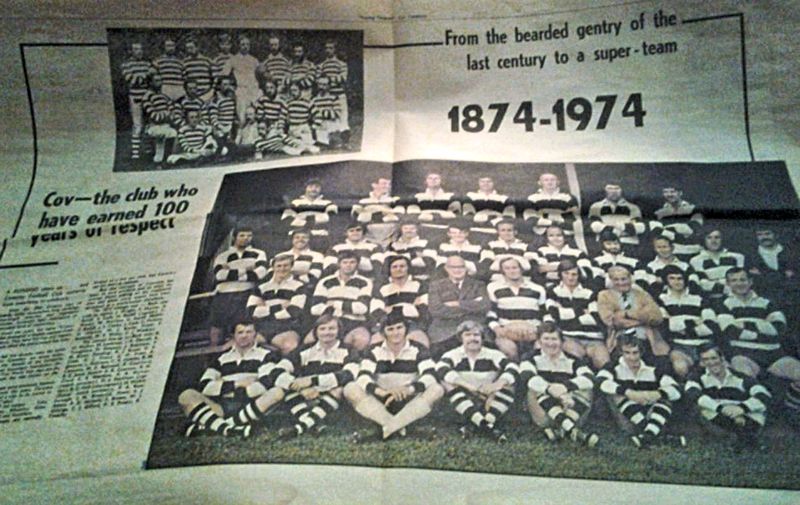
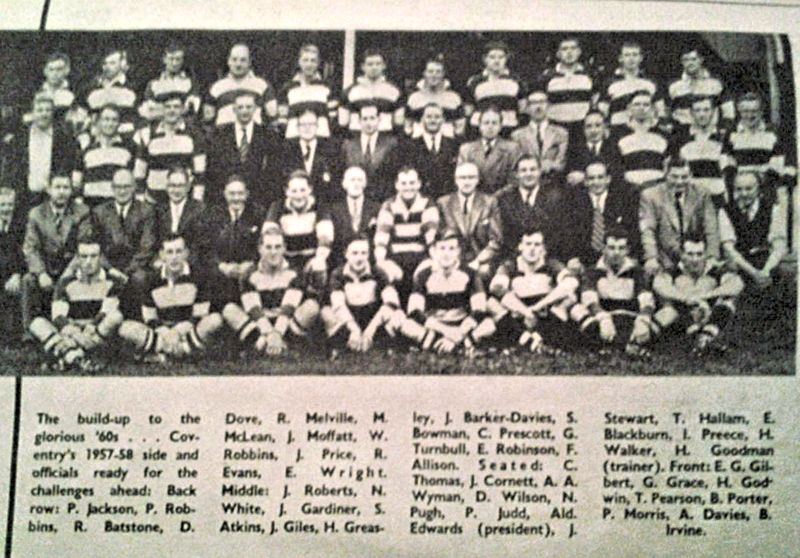
As well as cycling to and from Nuneaton to work each day, Brian also cycled to see Sarah several evenings a week when he had no training at Broad Street Club, which now had its own clubhouse on the Henley Road Ground. As Slim Whitman had a hit song with "O Rosemary, I love you" in the 1950s, Brian used to sing and whistle this for Sarah, whose middle name was Rosemary, as he cycled to meet her. He could be heard well before he arrived, as the residents in the flats laughingly commented! When they got engaged at Christmas they bought the ring from Elkay's Jewellers in Far Gosford Street, a shop owned by Mr. Louis Kutner, a lovely man. Elkay's was next door to Dudley's furniture shop, and opposite Jayne's, a high class dress/gown shop, part of which was subsequently used by a firm, possibly called Data Processing, and managed by Mrs. Alma Green, a friend of Sarah's from Blackwell Road since they had worked in data processing - punched card operating - at Alfred Herbert's.
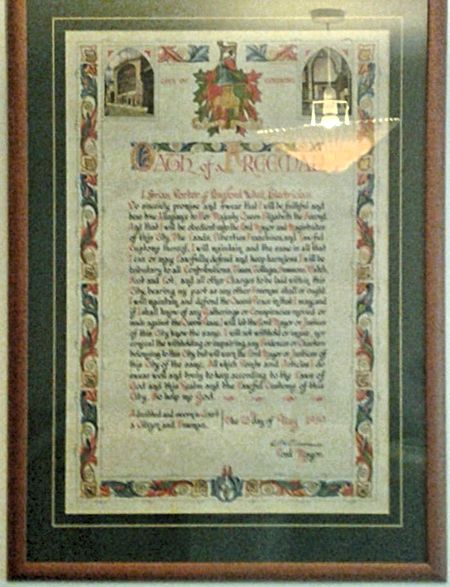
Brian and Sarah were separated for a couple of weeks when Brian went to Tenby for a holiday, and he bought her a lovely silver brooch with two hearts together with foliage, and the Mizpah text on them - "The Lord watch between thee and me when we are absent one from another" - little realising how much time they would eventually spend apart. Shortly after Sarah moved out to the new Council estate, Brian's elder sister Marge and her husband, Mick, together with their son, moved from their parents' house to one of the newly built houses in Willenhall quite close to Sarah. This was often a port of call when Brian took Sarah home. They enjoyed a hot cocoa and fresh bread and butter, before Brian returned home to Foleshill again. It was some while later that the No. 22 Willenhall bus turned near the Chase Hotel into Willenhall Lane and went on past Marge's house and down to turn round at the terminus at the end of Remembrance Road.
A few years before that, Brian went on an Outward Bound course in the beautiful wooded Dyfi estuary in Aberdovey, Snowdonia. The lads were aboard the HMS Churchill and took part in activities designed to improve self confidence and encourage leadership skills. It gave Brian a love of the sea and some lasting memories.
For years Brian continued his training and attended Coventry Technical College at the Butts in the evening for the theory part of his apprenticeship. He completed his six years in 1959 and was made A Freeman of The City of Coventry. He attended a ceremony at St. Mary's Guildhall at which he was congratulated by the Mayor of Coventry, who presented him with a large beautifully illuminated scroll with The Oath of a Freeman written below the Crest of Coventry City, on which is written "Camera Principis"; the chamber of Prince. There is also an elephant symbolising faith and strength, and it now also has a phoenix which symbolises Coventry's re-emergence from the ashes. The scroll is now framed and proudly hung at home.
 rian and Sarah were married at St, Pauls Church, Foleshill, on 17th October 1959, and with the help of Brian's special friend and mentor Eric Lambert they moved into Eric and Iris's old house in Beresford Avenue. Sarah's sister Barbara was married to Hugh, who was an excellent decorator and DIY man, and he very generously decorated the house inside and out with Brian's willing and enthusiastic help. Brian picked up a great deal of know how during this time given so freely.
rian and Sarah were married at St, Pauls Church, Foleshill, on 17th October 1959, and with the help of Brian's special friend and mentor Eric Lambert they moved into Eric and Iris's old house in Beresford Avenue. Sarah's sister Barbara was married to Hugh, who was an excellent decorator and DIY man, and he very generously decorated the house inside and out with Brian's willing and enthusiastic help. Brian picked up a great deal of know how during this time given so freely.
Don and Hazel were married two weeks earlier than Brian and Sarah, and so moved in first as we had all agreed we would share a house because we knew Brian and Don were waiting to be called up for National Service.
It was 1961 when both Brian and Don were still working as a maintenance electrician, and a metallurgist, at Sterling Metals, Nuneaton, when they were called up. Don went to Shawbury and Brian went to Bridgnorth for basic training. They were given their Service Number; Brian's was 5076589, the last three of which they always had to give, when addressed by an officer or a Senior Serviceman, instead of their name, and then they were kitted out with full uniform and each of them had a housewife, which needed some explanation from a newly married man! For about ten weeks there was hard physical and Service training and protocol to be learned, before the Passing Out Parade. As before, when Brian had expressed his desire to join the RAF in preference to the Army, we checked with his mother to see if it would be too painful for them to see those boys and her youngest son in blue, but she said she would love to come to his Passing Out Parade. So, as it was possible for only two people to attend the Passing Out Parade, Brian's father heard all about it when we returned home, no doubt quietly recalling the time he did his army service in the wars; a time about which he never spoke. We told him about the welcome, the band, the drill, and how one recruit was in civvies because he was so tall the RAF did not have a uniform to fit him! We were all so proud of Brian but sadly did not take any photographs. We only have one group photograph.
Brian was posted to RAF Gaydon to perform Air Traffic control duties, and had to travel to and from the base on his Francis Barnett motorbike, which he had bought from his brother Bill to begin with, but as winter came on it became clear that two wheels were not safe in the snow and ice. He decided to buy a B. S. A. Combination, a striking, more powerful bike with a rocket shaped sidecar!
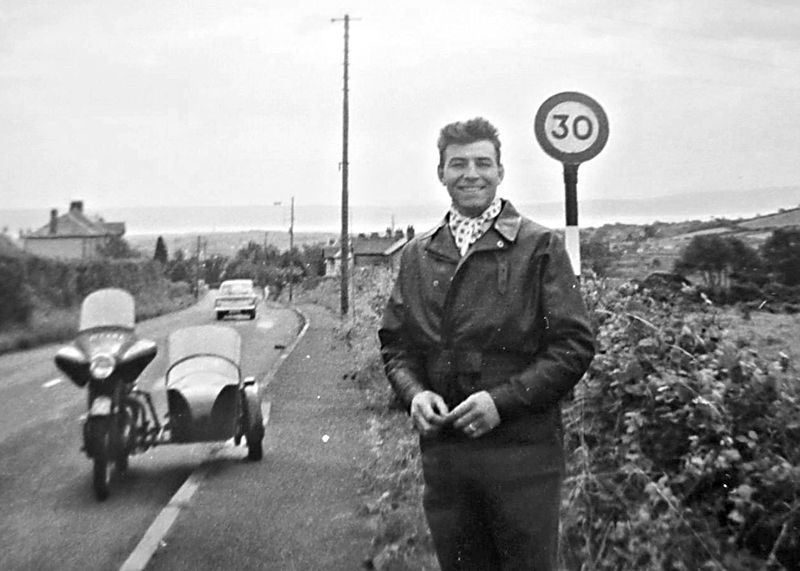
This made his journey to Gaydon Air Base possible throughout the two years, but it was not without event, as on one journey home a car crashed into him. The driver admitted he was at fault and they swapped details and it was agreed not to claim on the insurance, but he said, "If you call round when it's fixed, with the bill, we'll settle up". This was done, but when Brian called on the man in Bell Green and expected him to deal fairly and hand over the cash, the man said he knew nothing at all about it! Lessons were being learned. Brian was already orderly and able to keep his "quarters" clean - probably because growing up in a house with other Servicemen everyone was expected to do their bit, so he enjoyed his time in the RAF, and even more so because of the Rugby he played for Gaydon. The time passed quickly for him and perhaps, if he had had the experience when he was single, he would have become a regular.
On being discharged from the RAF after National Service it was decided to have a complete change as it was so dirty in the foundry, and due to his two year break it was an optimal time to leave, and so Brian did not return to his work at Sterling Metals, but instead took a job as a maintenance electrician at the new and as yet incomplete Lanchester College in the city centre. Don and Hazel had their first baby and had moved into their newly built house at Foxford, and Brian and Sarah continued to renovate their own home. One day when repairing the broken asbestos roof on the garage at the end of the garden, Brian, feeling pleased with his work, took a step back to admire it and fell through another panel on to his motor bike inside the garage! Fortunately he was only bruised but it could have been much worse. On one occasion after playing Rugby, Brian's mate knocked on the front door to tell Sarah he had been injured. Shocked, she said, "Where is he?". "Oh, he's in the car, he's just coming." was the reply. After checking he was not too badly injured Sarah exploded "Don't ever do that again! If Brian is at all able, he must always come in and let me know himself how he is". She knew Rugby was a tough game and could be very rough, sometimes resulting in serious injuries. Fortunately over the years Brian was able to weather the broken collar bone, cracked ribs and a broken nose, along with bruising and subsequent fluid problems he sustained. Brian also played cricket and squash regularly, but Rugby was always his passion. He continued playing at some level until he was in his fiftieth year.
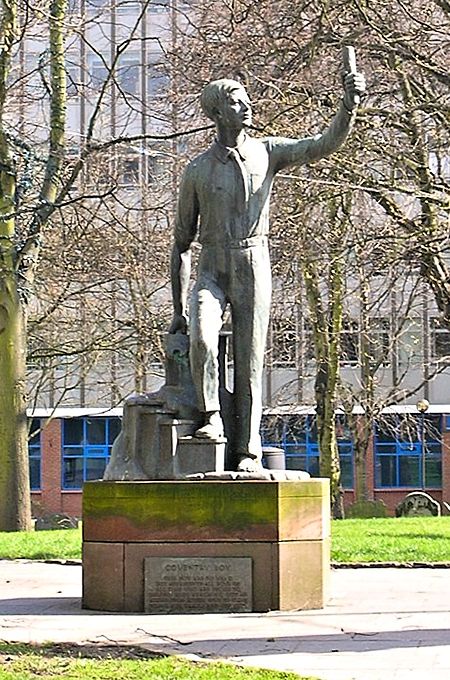
Although he did not have natural rhythm and was not a dancer, he did his best. It was great fun when a group of Broad Street friends went to Chesford Grange, Kenilworth, to a dance, and as the Cha Cha Cha was all the rage they made a formation team on the dance floor. It was such a laugh! They thought they were really something! More usual was the reality of going to Keith Jones' dancing studio in Cox Street and enjoying the music, but with Brian being guided around the floor by Sarah, squeezing the appropriate arm to tell him which foot to move! We loved Vaya Con Dios My Darling, along with the other songs of the time.
When they found out a baby was on the way Brian and Sarah sold up and moved to Poets Corner. Six months later their daughter was born, in a snowstorm, which delayed the midwife's arrival thereby intensifying proceedings and creating quite an experience for the new father! They adopted a baby boy three years later. They had by now outgrown the BSA combination motorbike and bought their first second hand car, a green Morris Minor with a split windscreen. This was a prized possession and much time was spent on renovating it. They decided that, with the help of the manual, they should re-grind the pistons. Sarah, as always, was a willing helper. They gathered rags and cloths and made sure that as they dismantled the engine everything was labelled. The wiring was labelled and the gaskets were removed. The pistons were re-ground, everything was cleaned, and at long last it was re-assembled. Job done!
The next drive they went on was to visit Hugh and Barbara at Willenhall Wood. The car seemed to perform well and they were pleased with their efforts, but on the return journey the car went slower and slower, they could have walked faster, but for the children! They eventually crawled into the pub car park at the end of the road where they lived, and it gave up the ghost! After seeing the family safely home Brian returned with his tools. He checked that it was fine with the Landlord of The Painted Lady, in Longfellow Road, and he set to work again. We laughed at ourselves and the great care we had taken when it was discovered that we had left the blocking cloths in the cylinder shafts!
While working at the Lanchester College of Technology Brian watched as the construction workers put the finishing touches to the new Coventry Cathedral, standing adjacent to the ruined St. Michael's Cathedral. Epstein's great St. Michael sculpture symbolising the conquest of good over evil hangs high on the red sandstone wall at the main entrance for all to see. Later, Brian also watched the erection of the Coventry Boy Statue, a boy who has one arm dressed correctly with the sleeve cuff-linked, and the other bare, with a spanner in his hand resting on a diminutive factory. The hand of the clothed arm is holding a scroll, which is held aloft. The Coventry Boy also wears a shoe on one foot only, the other one being bare. The statue was presented to the college by an anonymous group of benefactors from the Coventry Boy Foundation Trust, and which now stands in the College campus in Priory Street, opposite the Cathedral. It was designed by art student Reg Rudge, and cast in bronze, to represent the technical and craft skills embodied in modern Coventry, and bears the inscription:
|
"COVENTRY BOY THIS BOY HAS NO NAME BUT REPRESENTS ALL BOYS OF ALL TIME WHO ARE PROUD TO BELONG HERE REACHING OUT AS ALWAYS FROM ROUGH SPUN TO CLOSE WEAVE FOR FAMILY AND FOR CITY"
Foundry mark at base of bronze: This statue spoke directly to Brian, so proud to be a Coventry boy. |
 rian had undertaken further study and ventured into electronics, which was at the cutting edge of industry. He went into Systems engineering - the design and production of bespoke machines to take loads of various materials, such as plastic for prosthetics, or testing metals for aircraft construction, or suitable metal for drilling through seemingly impenetrable rock for tunnelling. He designed machines, which when used in wind tunnels, or on skid pads etc., tested stress or strain, crack and creep, and all effects on materials used. The product supplied by the companies for which Brian worked (both British and German) all had computer control, and were supplied with monitor and QWERTY keyboard. Engineering was advancing rapidly with the development of the micro-chip, and had already taken great strides since an innovative room-filling computer was installed at the Standard Motor Co, at Canley in the 1950s! Brian visited industries all over Britain and abroad; he visited establishments like Cardiff University, Edinburgh University, Salford University and Oxford University. He sought and gained inroads into places where research was being undertaken, like Road Research, he did business with many companies, like Moog engineering at Tewksbury and Renold Chain in Worcestershire, and travelled to countries such as Holland, Germany, France, Belgium, Portugal, Norway, America and Saudi Arabia. He visited for work purposes and never thought to take time for sight-seeing, even to places like Niagara Falls while he was there. As with Rugby, his work became his passion.
rian had undertaken further study and ventured into electronics, which was at the cutting edge of industry. He went into Systems engineering - the design and production of bespoke machines to take loads of various materials, such as plastic for prosthetics, or testing metals for aircraft construction, or suitable metal for drilling through seemingly impenetrable rock for tunnelling. He designed machines, which when used in wind tunnels, or on skid pads etc., tested stress or strain, crack and creep, and all effects on materials used. The product supplied by the companies for which Brian worked (both British and German) all had computer control, and were supplied with monitor and QWERTY keyboard. Engineering was advancing rapidly with the development of the micro-chip, and had already taken great strides since an innovative room-filling computer was installed at the Standard Motor Co, at Canley in the 1950s! Brian visited industries all over Britain and abroad; he visited establishments like Cardiff University, Edinburgh University, Salford University and Oxford University. He sought and gained inroads into places where research was being undertaken, like Road Research, he did business with many companies, like Moog engineering at Tewksbury and Renold Chain in Worcestershire, and travelled to countries such as Holland, Germany, France, Belgium, Portugal, Norway, America and Saudi Arabia. He visited for work purposes and never thought to take time for sight-seeing, even to places like Niagara Falls while he was there. As with Rugby, his work became his passion.
Customer Service was paramount to Brian, and it was therefore upsetting when one customer reneged on the contract and Brian had to take the case to the Small Claims Court. He won his case and afterwards the customer shook hands with him to show there were no hard feelings.
On another occasion, while trying to deliver a mega-tonne load to an Oxford University, the transporter could not negotiate around an island and the traffic had to be stopped in the middle of Oxford!
His attention to detail and his competitive quotes were obviously an asset to the firms Brian worked for, but his after-sales service and integrity were sought by his customers. He was well known as a good man to do business with.
Brian had always longed to have his own business, but either the time or the finances regularly presented obstacles, so this ambition was postponed. We moved from Kenilworth to Sherbourne. Finally conditions came together and along with a colleague who could develop software, they set up their own business. Along with the pleasure and excitement, this obviously brought a great deal of stress into their lives. His partner stayed in house and sought to supply State of the Art software, and Brian travelled seeking out contracts and drumming up business for their new enterprise. Slowly and steadily the business took off, but it was continual pressure and after six years Brian, especially, was feeling the strain, and it showed. In spite of his Well Man checks at the doctors he became ill. Following a fall and subsequent surgery for a massive brain haemorrhage, he spent months recuperating, beating the odds for survival, greatly helped by prayer and constant support from his Pharmacist daughter Jayne.
As part of the long recovery process Brian went to Watercolour art classes in Shottery with Jayne, and revealed hidden talent! With the help of George, a friend and neighbour, he took on an allotment growing potatoes, beans and strawberries, and he also spent time walking his retriever, Bryn, around the village. It became obvious that Brian needed more stimulation. After living in Sherbourne for twenty years we moved to the Cotswolds.
Here Brian was able to walk alone to the village, where he called in at the cafe from time to time for a chat, a cup of tea and a scone. He did a little shopping. He also loved going to the Baptist Church social afternoons where they had visiting speakers who talked about such things as the Stately Homes all along the river Windrush. He met the son of Reginald Joseph Mitchell, the inventor of the Spitfire, who signed copies of his book about his father. There was the added excitement of the granddaughter of Reginald Joseph Mitchell flying the Spitfire over the village in the summer, and all through the year there are sightings of, for instance, the Wellington bomber flying in to Brize Norton airbase. Helicopters and light aircraft are often seen too. The cricket club is within walking distance and he looked forward to the cricket season when he would spend whole afternoons watching the matches. There was the added attraction of refreshments. The village buzzed with tourists and residents alike and Brian made a lot of friends and acquaintances. He did a lot of gardening and loved picking the apples from the trees in the garden and sharing them with the neighbours.
He enjoyed train rides on the Toddington line, and on another occasion had his photograph taken with RAF personnel in a helicopter on the Brize Norton Airbase.
When the summer is over he spends time listening to music. He enjoys a wide range from Light Opera, or watching Charles Hazelwood conducting Beethoven or Mozart or other Master composers, to Country and Western, especially Dolly Parton or Glen Campbell. He also likes Neil Diamond. Simon and Garfunkel's Bridge Over Troubled Water is an all time favourite and he enjoys the Gaithers and Guy Penrod. He spends time with his stamps and has a huge collection. He likes researching aircraft, reading about exploration and archaeology and also about bridges and other engineering projects. He takes great interest in endeavour programmes on television or DVD, and he also became Fred Dibnah's No. 1 fan, being fascinated by steam engines, archaeology and also Fred's work as a Steeplejack and demolition expert. Brian loved Fred's direct yet humble approach; like Brian he was forever the learner no matter how expert we thought him.
 n spite of the fact that the years conspire against Brian, he remains, seventeen years on, a contented and very fulfilled man, approaching his eighties now, who wherever he is will always be A Coventry Boy at heart, who is dearly loved and who is justified in having Pride in the Past, and Faith in the Future.
n spite of the fact that the years conspire against Brian, he remains, seventeen years on, a contented and very fulfilled man, approaching his eighties now, who wherever he is will always be A Coventry Boy at heart, who is dearly loved and who is justified in having Pride in the Past, and Faith in the Future.
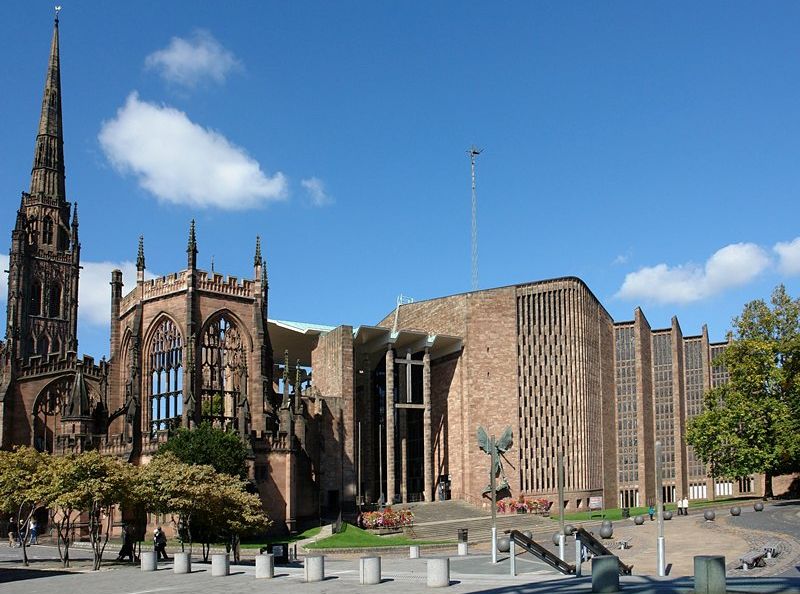
Website by Rob Orland © 2002 to 2026